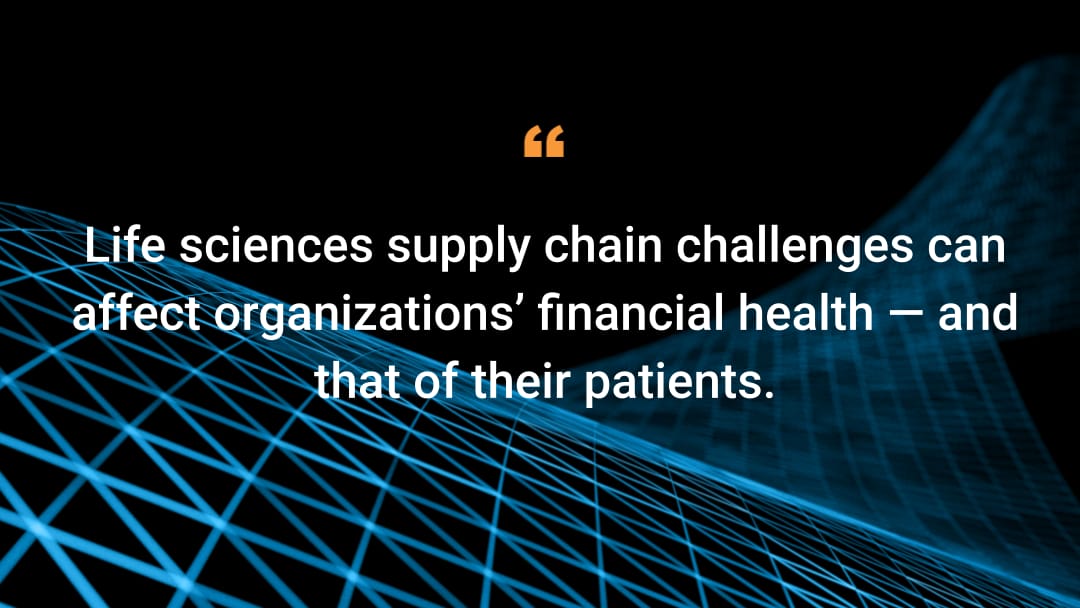Prioritizing the Pharmaceutical Supply Chain for Healthcare Resiliency

From Tickle Me Elmo dolls to toilet paper, demand can outstrip supply in the most headline-making ways. But those ways have rarely been life-threatening — until recently.
Dramatic weather patterns across the world are affecting the global supply chain. A tornado recently damaged a pharmaceutical warehouse facility, one that stored 25% of all sterile injectables for U.S. hospitals.
Although challenges in the pharma supply chain had to be addressed across the country, this crisis also offered up important takeaways about what the life sciences industry can — and should — do to promote greater resiliency.
Weathering the storm of geopolitical climates
Weather is far from the only challenge that’s putting pressure on life sciences and healthcare leaders. International tensions are rising across the world, and the geopolitical climate weighs heavily on the executives who responded to PwC’s 25th Annual Global CEO Survey.
Almost one-third of the respondents say that geopolitical conflict threatens their companies’ growth, and more than two-thirds cite it as an expected factor in supply chain disruption.
Geopolitical tensions are associated with more cybercrimes
Recent events show direct corollaries between geopolitical tensions and a higher volume of cybercrimes. One example includes members of the pro-Russia group Killnet, whose distributed denial-of-service attacks targeted healthcare entities in every U.S. state. It's important to note that groups of threat actors are not only targeting specific industries with advanced tactics, but some are also collaborating with other cybercriminals to maximize impact.
Life sciences supply chain challenges: higher costs
Life sciences supply chain challenges can affect organizations’ financial health — and that of their patients. The conflict in Ukraine has created serious issues with the costs of energy and raw materials, notes Medicines for Europe.
That group (formerly the European Generics Medicines Association) reports that record-high gas and electricity prices following the Russian invasion of Ukraine — compounded by raw materials costs that have risen between 50% and 160% and transportation costs that have risen up to 500% — are increasing the cost and supply of “affordable” medications.
Managing uncertainty in the supply chain
Regulatory and physical changes are already underway to address how to improve the pharmaceutical supply chain.
Earlier this year, a critical mass of leaders shared dismay about pharmaceutical shortages at a session of the European Parliament. EU health chief Stella Kyriakides cited as concerns a number of dependencies, including:
- Production capacity issues influenced by the global labor shortage
- A reduction in the production volume of drugs like amoxicillin during the pandemic
- More prescriptions written for such medications because of recent surges in COVID-19 cases
The production of medicines in China — where surges in COVID cases have affected output — has also been problematic for countries that depend on Asia for demand.
Managing uncertainty in the supply chain via localized sourcing
In June 2023, the bipartisan Medical Supply Chain Resilience Act was introduced in the United States. This act attempts to strengthen the medical goods supply chain by creating more manufacturing within the country rather than relying on distant international imports that are more susceptible to political or natural disaster disruptions.
Notably, U.S.-based corporations such as Johnson & Johnson and Becton, Dickinson and Company are moving away from production in China. Instead, they’re nearshoring and working with suppliers in Latin America. European pharmaceutical companies are also evaluating this tactic and are still considering the Czech Republic as a supplier despite recent drug shortages, notes BMI market research.
Shoring up with blockchain
One of the original intentions of introducing blockchain technology into the pharmaceutical supply chain was to monitor dangerous counterfeit drugs, though there are broader use cases today. Regulators, such as pharmacy inspectors, can monitor the rate of fake drugs entering the supply chain with more accuracy.
Blockchain provides increased transparency over other supply chain approaches, helping to reduce substandard or outdated drugs in the market. Integrating the company and the downstream supply chain members can also provide pharmaceutical suppliers with better demand forecasts.
Decentralization provides protection
Another advantage of blockchain technology is that processes don’t require intermediaries. Information and data are no longer bundled centrally on a server, but are instead decentralized on each individual node in the network. Individual nodes can be located anywhere around the world — meaning there are no problems in the blockchain network in the event of a failure in troubled regions.
Blockchain technology assists U.S. entities in adhering to the Drug Quality and Security Act (DQSA) and Title II of DQSA, the Drug Supply Chain Security Act. Those define the requirements for the electronic tracing at the package level of specific prescription drugs that are distributed across the United States.
Establishing proper frameworks
Besides clinical outcomes, there are important financial ones to consider when adopting new technology. Managing uncertainty in supply chain logistics must be a priority for pharmaceutical companies that want to stay competitive.
Creating an intelligent supply chain uncertainty framework — not unlike the well-established, respected, and often-used MITRE ATT&CK or the US National Institute of Standards and Technology (NIST) frameworks — is critical. This supply chain uncertainty framework should have a well-thought-out plan B, and even plans C and D, for what to do to prepare and react to natural or geopolitical disruptions.
An increased attack surface requires Zero Trust
Thinking outside the box to address supply concerns has increased life sciences’ collaboration in the healthcare ecosystem — including building partnerships in critical areas such as supply chain, clinical trials, and R&D. Today, many organizations are engaging with other companies outside their firewalls, but that broadens their potential attack surface.
Vikram Venkateswaran, Partner, Risk Advisory, at Deloitte India, notes that in one recent Deloitte survey, 70% of pharmaceutical technology leaders surveyed had already started working on a Zero Trust network that combines network, data, and access at the time of the study.
“With an increase in attacks such as the ones on the supply chain and distribution sectors, many pharmaceutical organizations are investing in third-party risk assessment for both technology and processes to enhance their ecosystems,” writes Venkateswaran.
Keep yourself protected
This is where Akamai plays a vital role in life sciences and pharmaceutical protection — and in enhancement of the entire healthcare ecosystem. You can read more about how blockchain drives innovation and investment across the pharmaceutical industry, or learn more about how an Akamai partnership can help.


